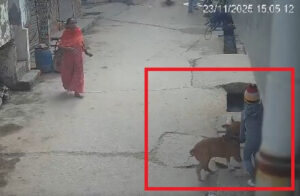India successfully test fires n-capable Agni-V ballistic missile

Indigenously developed long-range surface-to-surface ballistic missile, #Agni -V successfully tested. (File Photo)
Updated At 20:50 IST
Bhubaneswar, Jan 18 : India on Thursday successfully test fired its indigenously developed intercontinental surface-to-surface nuclear-capable ballistic missile Agni-V — the most potent and with the longest range in the Agni series – that can reach targets as far as Beijing.
Defence Minister Nirmala Sitharaman made the announcement in Chennai and said “We have successfully launched nuclear capable ballistic missile Agni-V today”.
The 5,000-km-range missile, that can carry a one-tonne warhead, was test fired from the Abdul Kalam Island off the Odisha coast at around 10 a.m.
This was the fifth test of the missile and the third consecutive one from a canister on a road mobile launcher. All the five missions have been successful. Sources added that this was the first user trial of the missile, and the success brings it closer to induction in the tri-service Strategic Forces Command.
“The flight performance of the missile was tracked and monitored by radars, range stations and tracking systems all through the mission. All objectives of the mission have been successfully met. This successful test of Agni-V reaffirms the country’s indigenous missile capabilities and further strengthens our credible deterrence,” an official statement said.
Sitharaman, while inaugurating the Defence Industry Development Meet at Chennai, shared her happiness on the successful flight test of Agni-5.
She congratulated DRDO on the successful feat and also lauded the industries that contributed to the manufacture of indigenous technologies that went into the making of the missile.
Chairman DRDO S. Christopher also congratulated Agni-V team and said that the fifth consecutive successful flight test is a major boost to the country’s defence capabilities.
The Agni-V missile was first tested in April 2012 and then in September 2013. The third launch, on January 31, was from a mobile canister.
The canisterised missile has a much longer shelf-life, with the container being made of special steel that absorbs the blast of the takeoff.
In the canisterised launch, a gas generator inside the canister ejects the missile up to a height of about 30 metres. A motor is then ignited to fire the missile.
The fourth test of the missile was delayed, initially being scheduled for December 2015, postponed to January 2016, and later to March 2016.
A technical snag meanwhile pushed the test further down, and it finally took place on December 26, 2016.
At that time, it was said to be the last development trial of the missile.
The Agni-V is the most advanced version of the Agni series, part of the Integrated Guided Missile Development Programme that started in the 1960s.
With this missile, India joins the US, Russia, the UK, France and China, which boast ICBM capabilities, when it tested its first Agni-V missile in 2012.
IANS





